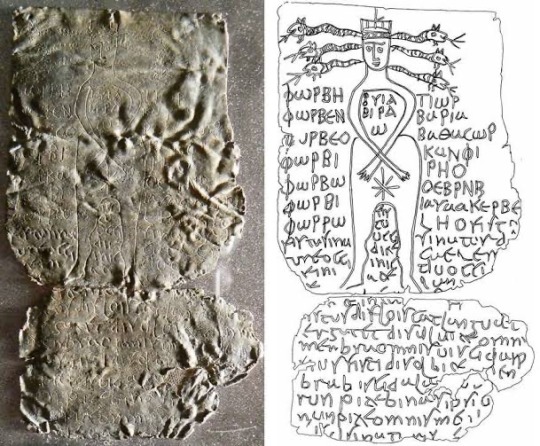#curse tablet
Text
“When researchers unrolled the piece of metal, they found a handwritten message in Gothic script that was hard to see with the naked eye."
(I love me some curse tablet in the morning.)
440 notes
·
View notes
Text
A digital curse tablet against transphobes
I register anyone who hates or attacks transgender people with the Gods.
I bind their tongues, I bind their hands, I bind their sinews.
I register them with Hecate, the Dread Persephone and the restless Daimones. Drag them down to Hades and cast them into Tartarus.
I register them with Demeter. Make their hate as barren as the crops when Persephone is away.
I register them with Artemis. Curse their bloodline so that they cannot pass on their hatred to their children.
I register them with Athena. Make their words jumbled and inarticulate.
I register them with Dionysus for hubris against Him. For denying his divine form and divine creation.
I register them with Aphrodite for slandering her child with Hermes.
Make the land unwalkable, the sea unsailable and their lives devoid of purpose.

#curse tablet#dionysus#hellenic polythiest#hellenic pagan#bacchus#witch#witchcraft#paganism#greek gods#helpol#hellenic gods#deity worship#devotional#pagan prayer
801 notes
·
View notes
Text
ITALY became a nation-state in the 19th century.Perhaps the most striking aspect of it’s witchcraft trials is that their bloodiest phase occurred in the Renaissance. Only 5 complete archives of the original 45 provincial tribunals in Italy proper have survived intact. (Herzig 2013.)

🇮🇹From the late fourteenth until the mid-fifteenth century, witchcraft scares ending with capital punishment broke out in Milan in 1385 and 1390, and in 1457 and 1472, And in 1515 and 1519.

As well as in the region of Como in 1456, 1460–82, 1487, and in 1512–17 and 1519–22.

🏔️Witch trials in Como had begun in the 1480s, with the burning of perhaps as many as forty-one witches. Prosecutions were renewed three decades later. The records of their proceedings were burned in 1782, when Emperor Joseph II suspended the inquisitorial tribunal in Como. One sixteenth-century chronicler describes the burning of three hundred women in Como in 1514.

The discrepancies among the sources are too great to arrive at any consensus, and estimates of the number of executions, range from about thirty to several hundreds.

Carlo Ginzburg's theory helped to understand the shamanistic roots of witchcraft beliefs. In addition, he shed light on how the theories of the elite filtered the narratives of the people and transformed them into Sabbath beliefs.

According Duni (2021) there were 650-750 executions in All Italy region -trials, between the 14th-18th centuries. Total number of trials was estimated to be 22000-33000.

😇In Milano & Como Cardinal Borromeo was directly involved with 7 of executions and indirectly in 64-100 cases.
🔥In 1569, the more moderate cardinal-inquisitors had the upper hand, when the Congregation refused to confirm the death sentences of seven women from Lecco who had confessed to participating in the witches’ sabbath and causing the death of children. One of the accused died as a result of her incarceration, but the Congregation prevented the execution of six others, notwithstanding pressure from Borromeo (1538–1584), archbishop of Milan, who wished to secure their death. ☠️

🛐St Borromeo (1538-84) was one of very few saints with the responsibility for holding a significant number of witchcraft trials. He was as relentless in his determination to punish anything related to magic and superstition as he was against Protestants.⛪️

In the Ancient Rome the other two types were: erotic curse tablets & circus curse tablets - for chariot races & gladiators.
”It was also rather normal for prostitutes to be practitioners of magic themselves. Their livelihood depended on their capacity to retain clients at all costs.” (Moretti 2019)

The Judical curse was seen in the Devil’s Advocate. Santeria priest binds the prosecutor’s fluent speach by using cow’s tongue and nails.
This long tradition of folk beliefs was more common in Italian witch trials also in the Early-Modern era - Sabbatical beliefs were more rare - usually the accused was on trial for the crime of heresy. Devil was more uncommon than other older gods in the court records.
Sources:
Debora Moretti (2019). Angels or Demons? Interactions and B... Religions, 10.
Duni, Matteo. 2019. Witchcraft and Witch Hunting in Late Medieval and Early Modern Italy
Herzig, T. (2013). Witchcraft Prosecutions in Italy.
Paolo Portone; Translated by Shannon Veneble.BORROMEO, ST. CARLO (1538–1584).
#witchcraft#witch#witches#folklore#history#italy#inquisition#early modern#witch trials#curse#spell#curse tablet
13 notes
·
View notes
Text

Mount Ebal Curse Tablet, thought to date to 1200 BCE
2 notes
·
View notes
Text
Bengt Ankarloo and Stuart Clark, eds. Witchcraft and Magic in Europe Volume 2: Ancient Greece and Rome. University of Pennsylvania Press. 1999. Paperback edition. 395 pages.
Shop link in bio.
instagram
#occult#magic#bookseller#occult books#sorcery#witchcraft#ancient history#ancient magic#ancient greece#ancient rome#curse tablet#hekate#hecate#Instagram
11 notes
·
View notes
Text
youtube
podcast vers.
The woman is from Uley, and she was called Saturnina. She has one name and so she's a commoner, but she's literate, and yet although she could write, she wasn't very wealthy. Why? Because one of her most precious possessions had been a linen cloth, and somebody had nicked it, almost certainly from her washing line. She was livid, and she panted her way over to the Temple of Mercury at Uley, went into the temple, and was confronted by a young man, stark naked, nine foot tall, made of limestone, with a hat with wings on his head, wings on sandals on his feet, and holding a rod with snakes coupling round it and wings on the end. The erudite would recognize Mercury; Saturnina didn't. She bought, or was given a lead curse tablet, and she began to write, and she wrote, "I do beseech the great god Mars," and then she had another look and crossed it out, and she then wrote, no, "I do implore the great god Silvanus," and then she had another look and thought, no, and then either she tumbled it, or else somebody gave her a nudge, and told her, and she wrote, "I do beseech Mercury," yes! And then she wrote a blood-curdling curse, I'd not have cared to be that thief. And it was then handed to an official, who put it in a machine that rolled it up, and it was then nailed to the wall it seems, so Mercury could fly by and collect it from his post box, and then go after the thief, if it worked. And it remained there until the temple crumbled at the end of the Roman empire, and the curse written by Saturnina fell into the earth, was covered by falling masonry, until another woman, Anne Woodward, excavated it in the late 1970s from the red Cotswold earth, and I feel that, at that moment, the spirit of Saturnina stood beside her, woman to woman, and the centuries were as nothing.
1 note
·
View note
Text

breakfast
#my tablet driver didnt work so i worked without pressure and stabilizer#fighting for my life#i like the colors so i will post it#sam and max#crunchchute art#my art#me wanting to do a cool actiony drawing. instead does this#i still fuck up the proportions what can i do. i make max's head too wide#the curse of not doing a proper initial sketch and just going right into lines
661 notes
·
View notes
Text

Update I have been gifted a new art tablet and oh my lort how do y’all draw with a screenless pad-



This last one was the first thing I drew with it LMAO
all of these were lil test doodles, but m a n I got mad respects to them gamers who can use this kinda tabloot with ease
#Plus like#i don’t have a proper computer to actually use it-#However I can connect it to my tablet and phone surprisingly??#The phone one would feel so cursed LMAO#Tiny lil screen with huge ass sketch pad#Also some of y’all have asked me what programs/device I use for most of my art-#It’s always just been a iPad procreate and a bamboo sketch stylus#However recently iv gotten a (passed down) pro with a gen 1 Apple Pencil#And O H B O Y does procreate LO VE to C R A S H#I DONT EVEN HAVE OTHER APPS ON THIS TABLOOT I USE IT PURELY FOR ART DJDJDJDDK#PAIIIIIIIIIIIN IDK HOW TO FIX ITTTT#welcome home#welcome home howdy#welcome home wally#welcome home frank#welcome home eddie#howdy pillar#wally darling#frank frankly#Eddie dear#robbie robs#New pad only takes a certain app and thankfully I know my way around that one somewhat#Not as comfortably as procreate but still smhhh need time to get used to it#Wallypillar#howdydarling#idk frank and Eddie’s ship name LMAO whoops
2K notes
·
View notes
Text

378 notes
·
View notes
Text

vash doodle while messing around on csp ;7;
#vash the stampede#trigun#trigun stampede#my art#sorry i am cursed to always draw vash as a butch he/him lesbian#first time trying csp tho IT'S SOO NICE#i like it alot but i haven't touched my tablet in many moons.....so it needs some getting used to#i also just discovered that my tablet is from um. 2013#she may be a bit old BUT SHE STILL WORKS AND THAT'S ALL THAT MATTERS.......
268 notes
·
View notes
Text
I was cursed by an ancient tablet and it turned me into a melanistic manta ray.
376 notes
·
View notes
Text
Curses in Greco-Roman Magic
Curse Tablets

Curse tablets were made from a sheet of metal, lead or wax. A basic curse tablet would have the name of the victim and an inscription of the curse. Many had images of the people on them. Incantations must be spoken or sung aloud while the tablet is being created.
Some curse tablets were made for people who had committed specific wrongs, like theft. These curses often petitioned the Gods and spoke of the damnation and death of the victim and their family. These tablets often petitioned Hecate, Persephone, Hermes and Hades.
Another type of curse tablet was against those who were your competition. For example, you might want to bind the feet of a runner so you can win the race. These curses were less intense and less likely to petition the Gods.
Another type of curse tablet was one that sought justice for ills done against the Gods. For example, it might petition Hera to punish someone who spoke poorly of her.
One type of curse tablet was specifically for future wrongs, such as breaking an oath or disturbing a grave. These curse tablets were public and in plain sight. They listed the ills that would befall you if you performed the actions specified in the tablet.
The final type of curse tablet was used in court. This type of tablet aimed to bind the tongue of the opposition so they would stumble in court when presenting their case. These tablets often petitioned Athena.
The curse tablet was then often rolled up and pierced with a nail and buried at crossroads, in a graveyard or in a spring or nymphaea.
The spirits of the restless dead (daimones) could also be petitioned to carry out curses. These were souls who had died young, violently or unmarried. They were also those who hadn’t been buried.
Many curse tablets include phrases that would not have made sense, but had magical power due to syllable variations, rhyming or being palindromes. One famous example is the phrase called the ephesia grammata: “ASKI KATASKI LIX TETRAX DAMNAMENEUS AISION”. Some of the words can be translated to have meaning, but only so far as the words hocus pocus come from butchered Latin meaning “this is my body”.
I will be putting up templates for curse tablets on my patreon, based on the way the ancients wrote their curses. If you’re interested, it’s only five dollars a month :)
Wax Dolls

Wax dolls were used to bind your enemies or to curse those who broke paths and rules. Wax dolls would sometimes be stuck with pins, bound with twine or melted over a flame depending on the curse being inflicted on the person. For binding a person, for example, the doll would be bound with twine. To have them waste away, the doll would be burned.
These dolls were often buried at cross roads in little coffins.
Evil Eye

The evil eye was as simple as an envious or jealous glance at a person. This jealousy cast bad luck onto the person who received the eye. Ancient ways of guarding against it included eye symbols, like we see today, but also phallic amulets and obscene hand gestures to distract the eye away from the person’s face.
Source: Edmonds, R (2021) Drawing Down the Moon, Princeton University Press
https://www.patreon.com/posts/curse-tablet-78903332?utm_medium=sharesheet&utm_source=sharesheet&utm_campaign=postshare_creator&utm_content=join_link
#dionysus#hellenic polythiest#hellenic pagan#bacchus#witch#witchcraft#paganism#greek gods#helpol#hellenic gods#deity worship#devotional#pagan prayer#altarspace#curse#curses#curse tablet#folk magic
29 notes
·
View notes
Text

I'm afraid that people in my job might now think I'm a little deranged. I mean I am but that's not the point
#cleaner version this time i gave him monocle because i forgot earlier lol#i need that tablet man#alastor#cursed cat alastor#hazbin hotel#hazbin alastor#hazbin hotel alastor#my art
71 notes
·
View notes
Text
society has collapsed but at least we got UNO

the gang's all here
@mightyanxiety @cokowiii
you guy's designs are absolutely baller
160 notes
·
View notes
Text
Bengt Ankarloo and Stuart Clark, eds. Witchcraft and Magic in Europe Volume 2: Ancient Greece and Rome. University of Pennsylvania Press. 1999. Paperback edition. 395 pages.
Shop link in bio.
instagram
#magic#sorcery#witchcraft#ancient history#ancient greece#ancient rome#necromancy#theurgy#daemons#demons#occult#curse tablet#Instagram
3 notes
·
View notes
